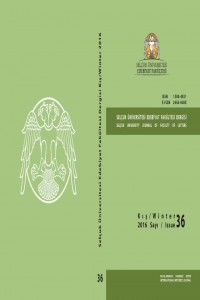Abstract
Daughter of
Prophet Muhammad, wife of Ali and mother of Hasan and Husayn, Fatimah was a
very important person in the history of Islam. She is a role model to Muslim
women with her morality and piousness. It is said that six months after the
death of Prophet Muhammad, Fatimah died because of deep sorrow. In this piece
of work, Fatimah’s sorrow for her father’s death, her sorrow and worry for her
two children – Hasan and Husayn – upon learning that she would die, her two
children’s grief for their mother, and Ali’s lament for his wife are profoundly
reflected in a plain language. Like many religious and sufic work, there are
many copies of this work in Turkish libraries. The copies we have worked with
are the ones archived with the number of 5905 and 5906, among the manuscripts
of Konya Koyunoğlu City and Museum Library. In the writing no. 5905, it is
clearly written that the date of 3 Muharram 1239 (9th of September, 1823) was
the completion date of the writing. The writings we have worked contained wovel
points, and therefore we had the chance to examine labial harmony. With this
information, it is understood that writing no. 5906 was copied beginning from
18th century. The work is a typical example of Old Oghuz Turkish language. The
copyright form of the writing belongs to the 15th century and after, and the
copied form belongs to the 18th century and after. There are studies of Mehmet
Mahfuz Söylemez, Muhammet Kuzubaş and Şaban Doğan, on different copies. With
this study, we aim to bring this representative work of Old Oghuz Turkish and
Islamic Turkish literature in the world of science. Future studies in line with
this purpose are very important to show the historical process of Turkish
language.
Keywords
References
- AKKUŞ, Metin (2003). “Fatıma”. Türk Dünyası Ortak Edebiyatı, Türk Dünyası Edebiyat Kavramları ve Terimleri Ansiklopedik Sözlüğü. C. 2. Ankara: Atatürk Kültür Merkezi Başkanlığı Yay. 439-440.
- ALBAYRAK, Nurettin (1993). Dînî Türk Halk Hikâyelerinden Geyik, Güvercin ve Deve Hikâyeleri -Kaynakları ve Metin Tesisi-. Yüksek Lisans Tezi. İstanbul: Marmara Ü.
- DOĞAN, Şaban (2012). “Bir Eski Oğuz Türkçesi Metni Hikâye-i Fâtıma ve Dil Özellikleri”. Akademik Bakış Dergisi (32): 1-20.
- KARTALLIOĞLU, Yavuz (2008). “Osmanlı Türkçesindeki Ekler Dudak Uyumuna Göre Nasıl Okunmalıdır?”. Turkish Studies 3 (6): 449-470.
- KARTALLIOĞLU, Yavuz (2011). Klasik Osmanlı Türkçesinde Eklerin Ses Düzeni (16, 17 ve 18. Yüzyıllar). Ankara: TDK Yay.
- KUZUBAŞ, Muhammet (2008). “Manzum Bir Destan Kitabı (Destân-ı Veysel Karânî, Vefât-ı Hz. Fâtıma, Vefât-ı Hz. İbrâhîm, Hikâyet-i Gügercin, Hikâyet-i Geyik)”. Uluslararası Sosyal Araştırmalar Dergisi 1 (2): 304-340.
- SÖYLEMEZ, Mehmet Mahfuz (2011). Dâstân-ı İbrâhîm Edhem, Dâstân-ı Fâtıma, Dâstân-ı Hâtun. Ankara: Türkiye Diyanet Vakfı Yay.
Abstract
Hz.
Peygamberin kızı, Hz. Ali’nin eşi ve Hz. Hasan ile Hüseyin’in annesi Hz. Fatıma
İslâm tarihinde önem kazanmış bir şahsiyettir. Ayrıca temiz ahlâkı, takva
sahibi oluşu gibi nedenlerle de Müslüman kadınlara örnek teşkil etmiştir. Hz.
Peygamberin ölümünden altı ay sonra Hz. Fatıma’nın üzüntüye dayanamayıp öldüğü
rivayet edilir. Çalışmamızın konusunu teşkil eden eserde Hz. Fatıma’nın
babasının ölümüyle çektiği acı, öleceğini öğrenmesi üzerine arkada bırakacağı
öksüzler (Hz. Hasan ve Hz. Hüseyin) için üzülüşü, çocuklarının Hz. Fatıma’nın
ölümüne üzülüşü, Hz. Ali’nin eşi Hz. Fatıma için yaktığı ağıt bütün
derinliğiyle ve son derece sade bir dille yansıtılmaktadır. Dini-tasavvufi
eserlerin genelinde olduğu gibi bu eserin de Türkiye kütüphanelerinde pek çok
yazma nüshası mevcuttur. Üzerinde çalıştığımız nüshalar Konya Koyunoğlu Şehir
ve Müze Kütüphanesi yazmaları arasında 5905 ve 5906 arşiv numarasıyla kayıtlı
olanlardır. 5905 Arşiv numaralı yazmada 3 Muharrem 1239 (9 Eylül 1823) tarihi açıkça
temmet kaydı olarak verilmektedir. Çalışmamızın temelini teşkil eden nüshaların
harekeli oluşu dudak uyumunu inceleme imkânını doğurmuştur. Buradan yola
çıkarak da 5906 arşiv numaralı yazmanın 18. yüzyıldan itibaren istinsah edilmiş
olabileceği anlaşılmaktadır. Eserin dili Eski Oğuz Türkçesinin tipik bir
örneğidir ve anlaşıldığı kadarıyla telif hâli 15. yüzyıl ve sonrasına, istinsah
hâli ise 18. yüzyıl ve sonrasına ait olmalıdır. Farklı nüshalar üzerinde Mehmet
Mahfuz Söylemez’in, Muhammet Kuzubaş’ın ve Şaban Doğan’ın çalışmaları
mevcuttur. Bu çalışmamızla Eski Oğuz Türkçesinin ve İslâmî Türk edebiyatının
temsilcisi olan eserlerden birini ilim âlemine kazandırmayı amaçlamış
bulunmaktayız. Bu doğrultuda ortaya konacak çalışmalar Türk dilinin tarihî seyrini
ortaya sermesi açısından önemlidir.
Keywords
References
- AKKUŞ, Metin (2003). “Fatıma”. Türk Dünyası Ortak Edebiyatı, Türk Dünyası Edebiyat Kavramları ve Terimleri Ansiklopedik Sözlüğü. C. 2. Ankara: Atatürk Kültür Merkezi Başkanlığı Yay. 439-440.
- ALBAYRAK, Nurettin (1993). Dînî Türk Halk Hikâyelerinden Geyik, Güvercin ve Deve Hikâyeleri -Kaynakları ve Metin Tesisi-. Yüksek Lisans Tezi. İstanbul: Marmara Ü.
- DOĞAN, Şaban (2012). “Bir Eski Oğuz Türkçesi Metni Hikâye-i Fâtıma ve Dil Özellikleri”. Akademik Bakış Dergisi (32): 1-20.
- KARTALLIOĞLU, Yavuz (2008). “Osmanlı Türkçesindeki Ekler Dudak Uyumuna Göre Nasıl Okunmalıdır?”. Turkish Studies 3 (6): 449-470.
- KARTALLIOĞLU, Yavuz (2011). Klasik Osmanlı Türkçesinde Eklerin Ses Düzeni (16, 17 ve 18. Yüzyıllar). Ankara: TDK Yay.
- KUZUBAŞ, Muhammet (2008). “Manzum Bir Destan Kitabı (Destân-ı Veysel Karânî, Vefât-ı Hz. Fâtıma, Vefât-ı Hz. İbrâhîm, Hikâyet-i Gügercin, Hikâyet-i Geyik)”. Uluslararası Sosyal Araştırmalar Dergisi 1 (2): 304-340.
- SÖYLEMEZ, Mehmet Mahfuz (2011). Dâstân-ı İbrâhîm Edhem, Dâstân-ı Fâtıma, Dâstân-ı Hâtun. Ankara: Türkiye Diyanet Vakfı Yay.
Details
| Journal Section | Articles |
|---|---|
| Authors | |
| Publication Date | December 23, 2016 |
| Submission Date | August 22, 2016 |
| Published in Issue | Year 2016 Issue: 36 |
Selcuk University Journal of Faculty of Letters will start accepting articles for 2025 issues on Dergipark as of September 15, 2024.

